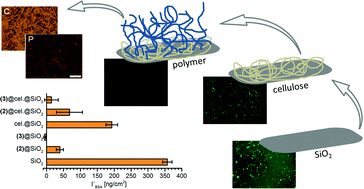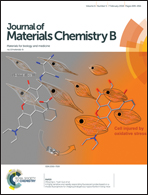Smart functional polymer coatings for paper with anti-fouling properties†
Abstract
Cellulose, as the main component of paper, is becoming more and more important for several high tech applications because of its beneficial properties, such as abundance, low cost, renewability, mechanical robustness and biocompatibility. To make cellulose accessable for new applications it is necessary to introduce new properties, which can be done by surface modification e.g. grafting of polymers onto surfaces. In this work, two comb copolymers, poly[(2-methyl-2-oxazoline methacrylate)-co-glycidyl methacrylate] and poly[(2-methacryloyloxyethyl phosphorylcholine)-co-glycidyl methacrylate], were synthesized by free radical polymerization of glycidyl methacrylate and oligo(2-methyl-2-oxazoline) as well as 2-methacryloyloxyethyl phosphorylcholine. After extensive characterization the polymers were covalently attached to thin cellulose model layers and filter paper using a one-step grafting-to approach. For the comprehensive analysis of these layers, thin cellulose films were fabricated on silicon wafers by spin coating of trimethylsilyl cellulose followed by acid hydrolysis which resulted in homogeneous layers as substrates for the grafting process of the functional polymers. The layers were characterized by X-ray photoelectron spectroscopy (XPS), attenuated total reflectance-Fourier transform infrared spectroscopy (ATR-FTIR), atomic force microscopy (AFM) and energy-dispersive X-ray spectroscopy (EDX). To demonstrate the high potential of such polymer-modified cellulose materials, protein repellance of the cellulose films, containing peptidomimetic 2-methyl-2-oxazoline and zwitterionic phosphorylcholine groups after successful functionalization, is shown. Cell adhesion experiments using Bacillus subtilis, Escherichia coli and Saccharomyces cerevisiae indicate the considerable anti-fouling capacity against both Gram-positive and Gram-negatve bacteria as well as the yeast fungus.



 Please wait while we load your content...
Please wait while we load your content...